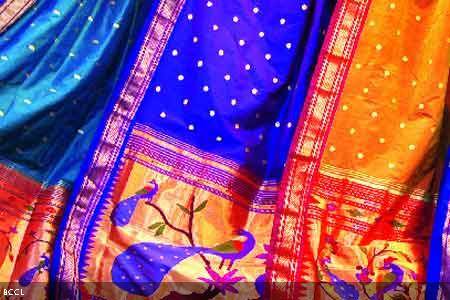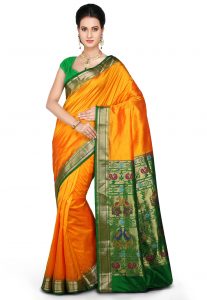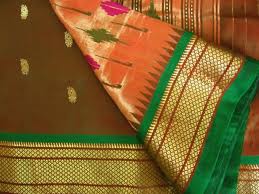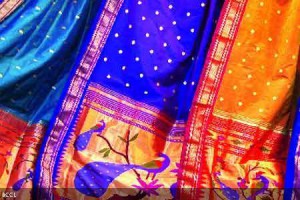
Paithani Saree
Amidst the splendid culture of the state of Maharashtra lies a quaint little town called Paithan in Aurangabad. Rich in its own cultural heritage, the small town holds a mighty tradition; that of churning out Paithani saris which are synonymous to Maharashtrian or Marathi ethos.
Origin and History
Named after the town responsible for its inception, the Paithani saris are made from exquisite silk and are hand woven. They are considered to be the richest saris in all Maharashtra. Paithani saris are said to be hand woven poems in gold and silk. They are a symbol of the intellectually refined elites. The craft of weaving the sari was invented in 200 B.C. and flourished during the Satvahana era. Ever since then, the Paithani sari has become a coveted heirloom that is passed on from generation to generation. Since it is mostly the creation of womenfolk, the mother passes this heirloom on to her daughter. In the ancient times, the Paithani sari was no less than an ornamental treasure and was paid for by the western travelers in gold and gems. Till date, the real Paithani saris are hand woven with real silver or gold and pure silk.
Style & Attire
A true Paithani sari is characterized by the borders of an oblique and square design having a pallu with a peacock. They are available in kaleidoscope colors and this effect is achieved by varying the weave. A particular colour is used for weaving lengthwise while another is used width wise. The design woven on the border separates it from all other saris. The greatest specialty of Paithani lies in its pallu wherein various distinctive motifs such as bangdimors, asavali, shikharkhana, gazwel, akroti, Ajanta Lotus are used. The Paithani sari can also have edges lined with rare gems and precious pearls.
The Making
Despite the craft being centuries old, the Paithani sari is still woven in the same traditional manner. It is woven with extreme caution as the silk threaded sticks are very fragile. This makes Paithani one such fabric that cannot be matched with any other fabric of its kind. The motifs on pallu can vary vastly from mangoes to peacocks and even lotuses. Some designs are also borrowed from the architecture of the Ajanta Cave. The creation of a Paithani requires skilled labour and artisans having in-depth knowledge of the fabric, its threads as well as its dyes. The time taken to create a Paithani can range from anything between two months to a year depending upon the pallu and the border. Its manufacturing can also cost anything from sixty thousand rupees to five lakh rupees.
Sources of Inspiration

Handloom Pure Paithani Silk Saree in Mustard
The most common subjects used as inspirations for the embroidery were wedding scenes. As a result, the Paithani was not only exquisite but also a vivid vision in silk and gold. The Paithani is an essential part of the bride’s dowry that was expected to have learnt this craft at a very tender age.
As it is a dowry luxury, the handicraft depends solely upon occasions such as weddings and other such ceremonies. It is worn by the women folk only on such special occasions. Brides are considered to be the all-rounders if they are well trained in the craft of embroidery of the Paithani in parts of Maharashtra where this handicraft is still considered as a matter of pride and prestige.
Global Appeal
This fabric has gained popularity beyond the boundaries of Maharashtra and has managed to capture the hearts of people in India, U.S, U.K, and Australia.
Wearing the Attire
If you wish to adorn the Maharashtrian look, then chunky jewelry, with heavy pendants coupled with headgears, kamarbundhs, and clunky bracelets could enhance the look. The focus on all these accessories will only count if they are in gold and enhance the natural beauty of the Paithani.
Suitability
This timeless artistic fabric can suit any formal occasion as well as celebration like get-togethers, corporate bashes, social parties and other events. Its vivid hues make it the center of attraction at any gathering and adorn the wearer with timeless beauty and grace, making it perfect for such occasions.
Maintenance
It is recommended to dry clean the Paithani sari and keep it away from harsh sunlight which might damage its silken threads. The gold zari may get frayed upon tough washing.
Interesting Facts
- The Paithani involves the usage of vivid colors, tints and tones which are unique to its fabric.
- The vegetable dyes are specially prepared
- The hues in which the Paithani dyes are formed include colors such as lavender, red, purple, ochre, sky blue, Prussian blue, magenta, peach pink, royal blue, violet red, Pasila, Gujri and Mirani.
- Gifting Paithani saris in a girl’s wedding trousseau is customary in the region of Maharashtra
References
Categories: Textiles


